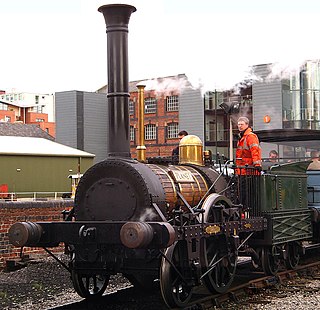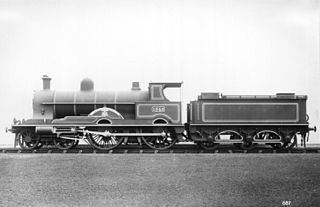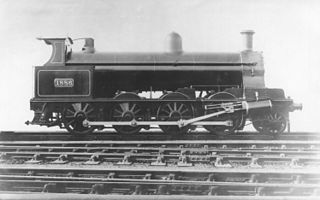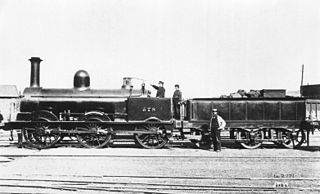George Whale was an English locomotive engineer who was born in Bocking, Essex, and educated in Lewisham, London. He worked for the London and North Western Railway (LNWR).
Locomotives of the London and North Western Railway. The London and North Western Railway (LNWR) Locomotive Department was headquartered at Crewe from 1862. The Crewe Works had been built in 1840–43 by the Grand Junction Railway (GJR).

Planet was an early steam locomotive built in 1830 by Robert Stephenson and Company for the Liverpool and Manchester Railway.

The LNWR 380 Class was a class of 0-8-4T steam tank locomotives designed by H. P. M. Beames. Although designed under the LNWR regime they appeared as LMS locomotives after the 1923 grouping. They were essentially an extended version of the 1185 Class 0-8-2T with a longer bunker, and were also related to the 0-8-0 freight engines. Their main area of work was to be in South Wales.

The London and North Western Railway (LNWR) Prince of Wales Class was a class of express passenger locomotive. It was in effect, a superheated version of the Experiment Class 4-6-0.

The London and North Western Railway (LNWR) George the Fifth Class was a class of 4-4-0 passenger steam locomotive.

The London and North Western Railway (LNWR) "Precursor" Class was a type of 4-4-0 ("American") steam locomotive designed by the company's Chief Mechanical Engineer, George Whale. Introduced in 1904, it should not be confused with the LNWR 2-4-0 "Precursor" Class of 1874 designed by Francis Webb, the last example of which was scrapped in 1895. In 1906, a 4-4-2T ("Atlantic") tank variant of Webb's engine, the "Precursor Tank" Class, also entered service.

The London and North Western Railway (LNWR) Experiment Class was a class of 4-6-0 steam locomotive designed by George Whale.

The London and North Western Railway (LNWR) 19in Express Goods Class, otherwise known as the Experiment Goods Class was a class of 4-6-0 steam locomotives. They were essentially a smaller wheeled version of the Whale's Experiment Class and were an early attempt at a mixed traffic engine.

The London and North Western Railway (LNWR) Jubilee Class was a class of 4-4-0 4-cylinder compound locomotives by F.W. Webb. A total of forty were built from 1897–1900.

The London and North Western Railway (LNWR) Alfred the Great class, after modification known as the Benbow Class was a class of 4-4-0 4-cylinder compound locomotives by F.W. Webb. A total of forty were built from 1901–1903. They were a development of the Jubilee Class, with a slightly larger boiler.

The LNWR 317 class, consisted of a class of 20 square saddle-tanked steam locomotives built by the London and North Western Railway at their Crewe Works between 1896 and 1901. They had a very short coupled wheelbase, with a trailing Bissel truck to carry weight.

The London and North Western Railway (LNWR) Class B was a class of 0-8-0 steam locomotives introduced in 1901. A development of the three-cylinder compound Class A, they had a 4-cylinder compound arrangement. 170 were built between 1901-1904.

The London and North Western Railway (LNWR) Class C1 was a class of 0-8-0 steam locomotives. 34 were rebuilt by Charles Bowen Cooke from Class A 3-cylinder compounds between 1909 and 1912.

The London and North Western Railway (LNWR) Class E was a class of 2-8-0 steam locomotives in service between 1904 and 1928.

The London and North Western Railway (LNWR) Class F was a class of 2-8-0 steam locomotives in service between 1906 and 1928.

The London and North Western Railway Experiment Class was a series of 30 three-cylinder 2-(2-2)-0 compound locomotives designed by Francis Webb for the London and North Western Railway between 1882 and 1884. They were Webb’s first large-scale experiment with a class of express compound locomotives, and the first engine was named accordingly. They were followed by a class of similar, but larger locomotives, that featured larger boilers and smaller driving wheels – the LNWR Dreadnought Class.

The London and North Western Railway (LNWR) 4ft Shunter was a class of 0-4-0ST steam locomotives. Introduced in 1863 by Ramsbottom, 26 were built in 1863–1865, 10 in 1870, 10 in 1872, and 10 in 1892. The last three of the latter batch were soon rebuilt as 0-4-2ST crane tanks. They survived into LMS ownership in 1923 and the last one was withdrawn in 1933.

The London and North Western Railway (LNWR) DX Goods class was a class of 0-6-0 steam locomotive, designed by John Ramsbottom for freight duties. 943 were constructed, making them the largest single class of steam locomotives built in the United Kingdom. Despite this, none were preserved.

The LNWR 18-inch Goods was a class of 310 0-6-0 freight steam locomotives built by the London and North Western Railway at their Crewe Works between 1880 and 1902.


















